1. IONS PUSHED TO ONE SIDE OF THE STALK
3. BOL'S IN VERTICAL MOTION - THE LORENTZ FORCE
4. BOL'S IN VERTICAL MOTION - PART 2
5. THE SUPERBOL AND ALTERNATING CURRENTS
9. THE EARTHCURRENT - PART 2
13. MAGNETIC DUST SUCKED IN AND SPRAYED OUT
When the earthcurrent consists of electrons then the ionized air tubes that conduct the electrons, consist of positive electric charged molecules (ions). There is assumed a voltage between the soil and the air above the crop that causes the earthcurrent. Let's assume the voltage drives the electrons upward and the positive ions downward along their tubes. The molecules that the positive ions are, are heavy and large and therefore their speed is thousands of times slower than the speed of the electrons. Nevertheless this downward speed of the molecules can be regarded as a downward movement of the earthcurrent as a whole with respect to the surface of the crop. You can in mind move along with this downward speed, making the positive ions of the earthcurrent standing still with respect to you. In this new frame of reference the soil with all the crop is moving upward (and the electrons of the earthcurrent move with a little larger speed upward). In this new frame of reference the crop is moving upward with respect to the magnetic field of the earthcurrent and will experience a radial forcefield (Lorentz force) which would down the crop radially, see fig. 9.1, provided threshold ion density in the stalks is achieved.
According to accepted rules in electricity, when the electrons move upward the current they form runs in the opposite direction, from the air into the soil that is here. In the frame of reference that comoves with the ions in the tube of air, the current is entirely carried by the electrons.
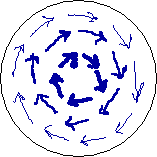
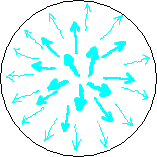


Fig. 9.1
Views are from above onto the soil, the soil is behind the pictured planes.
Red electric current arrow and grey velocity arrow are not shown.
red = electric currents and electric charges
green = crop
light blue = force
E = electric
deep blue = magnets and magnetic field
brown = soil
grey = velocity
M = magnetic
This is seldom observed. But in combination with a magnetic field of a BoL that downs crop circular, one could obtain a spiraled downed cropcircle and that is observed often enough.
So far the earthcurrent is taken as electrons going from the earth surface into the sky. But maybe it can be the other way around too, the electrons going from the sky into the soil. The positive air tube ions then move upward, which also is the direction of the electric current. Comoving with the upward motion of the earthcurrent yield a new frame of reference in which the soil is receding when viewed from above, instead of coming nearer. So in the new frame the direction of the magnetic field as well as the direction of motion of the crop in that magnetic field reverses. As a consequence the force field is still outward, the crop is downed inward. As a result of a constant earthcurrent alone, outward downed crop seems not to occur. This is in concordance with most observations: outward downed crop at the edges of a crop circle would make the edges untidy, which is seldom observed.
Let's sum two Lorentz forces, one from the magnetic field of a descending BoL and one from the magnetic field of the earthcurrent, see fig. 9.2. The Lorentz force F from the BoL's magnetic field is:
F(Lorentz force on ion in the crop) = q(ion in the crop) * v(ion in the crop) X B(BoL).
Here F = Lorentz force, q = electric charge (of an ion in the crop), B(BoL) = magnetic field of the BoL, v(ion in the crop) is the velocity of the ion in the crop relative to B(BoL). Except for q which is just a number, all the quantities in the formula are vectors. The * sign is a product sign, X is the vector outer product. When changing from magnetic field (dark blue) to force (light blue) one uses the vector outer product.
![]() math start
math start ![]()
Outer product X of velocity vector and magnetic field vector. Magnetic field B, force F and velocity v are vectors, quantities that have a value and a direction. A velocity of 10 m/s (36 km/hour) to the north is a velocity vector with value 10 and direction north. The outer product v X B yields a vector too. When velocity and magnetic field are perpendicular to each other, the value of their outer product X is the same as the value of the well known product *. One just multiplies the values then. We always used the horizontal component of the magnetic field of the BoL and chose the velocity of the BoL to be vertical, so they indeed have been perpendicular so far. The direction of the force vector F as result of the multiplication X, is always perpendicular to velocity v as well as perpendicular to magnetic field B, an unfamiliar property you have to get used to.
Direction of the force field vector. When the magnetic field is clockwise and the velocity is upward, then there are two possibilities for the direction of the outer product vector: outward and inward. Which of the two is to be taken? Take a right-threaded screw and put its point there where the velocity vector and the magnetic field vector both starts. Lay the screw so that it is perpendicular to both velocity and magnetic field vectors, while keeping the screw point at the intersection point. Imagine a piece of wood at the intersection point and imagine the magnetic field vector being fixed onto the piece of wood. Imagine the velocity vector fixed onto the screw. When you now screw the screw into the wood in such a way that the velocity vector moves ALONG THE SHORTEST ROUTE to the magnetic field vector, then the screw will advance in the direction of the force field vector.
You soon find out that it doesn't matter if the screw is turned 180 degrees. Take two identical right-threaded screws and put them in line with each other with the blunt sides together. Now hold the two blunt ends between thumb and forefinger in such a way that the blunt parts are both obscured. Now you see one single right-threaded screw with two sharp points at both ends and no blunt part to use for the screwdriver. Turn it upside down and back again. You will see no difference, when upside
it looks precisely the same as when down
. Mathematically it is meaningless to distinguish between a right positioned screw and an upside down one.
As you can check in figures like 2.2 (at page 2 that is), the magnetic field around a wire and the current through the wire always fit to each other as the rotation of a right-threaded screw and its advance direction in a piece of wood.
Also mark the difference when you multiply B X v, instead of v X B. In B X v the B-vector is mounted to the screw while the v vector would be fixed on the piece of wood.
![]() math stop
math stop ![]()
In the Lorentz formula the magnetic field is always regarded as standing still. A magnetic field (a constant magnetic field, that is a magnetic field that doesn't change in time) causes no force on an electric charge that is standing still in that magnetic field. Check the formula, if v = 0 then F = 0. So it is important to establish what precisely is the standing still state of the magnetic field. It is the only frame of reference where the force of the magnetic field on the electric particles like ions in the crop is absent. Take as a rule that the Lorentz force formula may only be applied properly in the frame where the magnetic field is standing still.
Assume there is a BoL. Assume the BoL is descending into the standing still crop. It descends onto the soil where it hits the ground and disappears. From page 4 we know that, working on the ions in the crop 2 inches above the soil, the magnetic field of the lower part of the BoL is not counteracted by the opposite influence of the corresponding upper part of the BoL. When the BoL rises from the soil to above the crop, or descends from above the crop to the soil, in both cases it is the lower part of the BoL that actually does the work of concentrating ions to one side of the stalk. Therefore we take the magnetic field of the BoL in fig. 9.2 as it is in the lower part of the BoL.
For convenience we assume both the magnetic field of the BoL as well as the magnetic field of the earthcurrent to be constant in time.
The Lorentz force from the earthcurrent's magnetic field on an ion q in the crop is:
F(Lorentz force on ion in the crop) = q(ion in the crop) * v(ion in the crop) X B(earthcurrent).
B(earthcurrent) = the magnetic field of the earthcurrent, v(ion in the crop) is the velocity of the ion in the crop relative to B(earthcurrent).
v(ion in the crop) in the magnetic field of the BoL (first formula) is just the velocity of the BoL relative to the soil, but then taken in reversed direction. v(ion in the crop) in the magnetic field of the earthcurrent equals, in reversed direction, the relative small velocity of the positive electric ions in the tube of air (second formula). The velocity of the BoL is not necessarilly the same as the velocity of the tube of positive ions, see fig. 9.2 (1) and (2). If the velocities differ, then their magnetic fields are moving relative to each other. It would no longer be possible to stand still relative to both magnetic fields at the same time.
But in this case they might be equal. From Fig. 8.3 en 8.4 (opens popup) we know the BoL will tend to come to a standstill with respect to the earthcurrents' magnetic field.
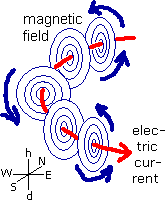
Magnetic field of the BoL
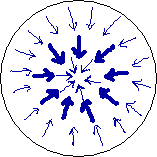 PLUS
PLUS
 EQUALS
EQUALS
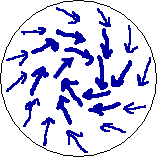
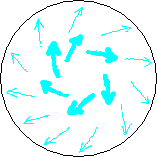
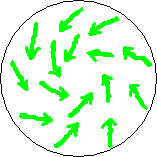

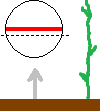 (1)
(1)
 (2)
(2)

Fig. 9.2
The inward directed magnetic field (first dark blue circle in fig. 9.2) is from a BoL. The clockwise circulating magnetic field that is added to it (second circle), is the magnetic field of the earthcurrent - mind clockwise magnetic field of an earthcurrent always combines with upward velocity of the soil. The light blue force arrows are meant to be drawn perpendicular to the magnetic field arrows at the same place.
As said at page 5, the alternating part of the circlecurrent might be induced by the earthcurrent and thus is fully determined by the earthcurrent. However, the direct part of the circlecurrent can be chosen freely. When the earthcurrent runs through the center of the circlecurrent, the circlecurrent traces a magnetic field line of the earthcurrent, making sure it is by no means hindered by it. That is, at page 8 is argued the circlecurrent then has to stand still with respect to the earthcurrent, the BoL comoves with the tube of positive ions of the earthcurrent.
Let's choose the circlecurrent of the BoL to run in the other direction. The magnetic field of the lower part of the BoL would point outward then, see fig 9.3.
Let's choose the earthcurrent to stream upward (and the electrons stream downward into the soil). Then its magnetic field circulates counterclockwise. Mind this is always accompanied by a relative downward velocity of the soil. And, thus, a downward velocity of the soil as observed from the BoL too, the BoL moves upward when seen from the soil. Fig. 8.3 and fig. 8.4 indicate that when the BoL is standing still relative to the eartcurrent from which it feels it magnetic field, it will not be hindered by it.
As you see, since the magnetic field sum (3rd dark blue circle) reversed direction and the relative velocity does so too, the resulting force field remains the same and so will be the anticlockwise downing of the crop.
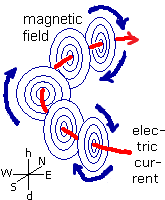
Magnetic field of the BoL
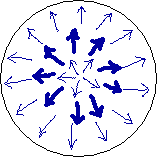 PLUS
PLUS
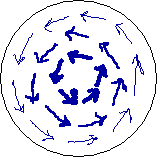 EQUALS
EQUALS
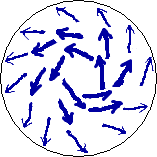



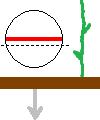 (3)
(3)
 (4)
(4)

Fig. 9.3
Clockwise downing can be achieved by taking the circlecurrent (the direct part of the circlecurrent) to run the other direction while leaving all the other things unchanged. Start again with fig. 9.2 and only change circlecurrent direction. We summarize:
(IN = INWARD, OUT = OUTWARD, CL = CLOCKWISE, ANTICL = ANTICLOCKWISE, UP = soil is moving upward, DOWN = soil is moving downward)
| Fig 9.2 | IN + CL = IN CL | OUT CL | IN ANTICL | UP |
| Fig 9.3 | OUT + ANTICL = OUT ANTICL | OUT CL | IN ANTICL | DOWN |
| Fig 9.4 | OUT + CL = OUT CL | OUT ANTICL | IN CL | UP |

Magnetic field of the BoL
 PLUS
PLUS
 EQUALS
EQUALS
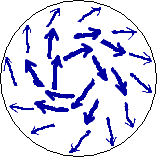
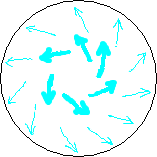
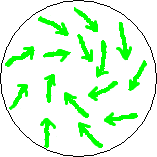

 (1)
(1)
 (2)
(2)

Fig. 9.4
As you see, when you carefully perform the vector multiplication of velocity and magnetic field, the force field is outward again, resulting in inward crop downing, thus yielding a tidy border of the crop circle.

Not yet finished, but tidy borders
The next thing we do is that we add an alternating current to the earthcurrent in just the same way as we did with the circlecurrent at page 5: the maximum of the alternating part of the current doesn't exceed the strength of the constant part. So an upward earthcurrent will indeed always stream upward, from the earth to the sky, and only differ in strength in the course of time. Maybe it is better to speak of a pulsed current since the current isn't really alternating in direction. We take the superimposed alternating current not necessarilly to be a regular alternation, nor in time nor in strength.
One possibility immediately emerging then is that the earthcurrent drives the circlecurrent by EM induction. The magnetic field of the earthcurrent then is relatively weak because caused by the motion of the ion molecules which is relatively slow. The magnetic field of the circlecurrent is weak compared to that of the earthcurrent because the circlecurrent is an induced derivative of the earthcurrent. For convenience we assume the resulting magnetic field strengths turn out to be comparable.
If the strength of the earthcurrent varies between 6 and 10 (just illustrative numbers!) then the direct part has strength 6 and the alternating part varies between 0 (non-existent) and 4. One can think this decomposed too as a direct part of 8 and an alternating part that varies between -2 and 2, just like an ordinary alternating current: 8 - 2 = 6 and 8 + 2 = 10. The direct part of 8 doesn't contribute to the induction that drives the circlecurrent of the BoL.
A computation with the formulas of electromagnetism would be appropriate here to make a first estimation whether all this possibly could work.
The magnetic field of the pulsed earthcurrent has a different strength from moment to moment, so it is emitting electromagnetic radiation then.
In the mean time I have a more substantial proposal about what keeps the circlecurrent and the whole BoL together. That's on the next page.